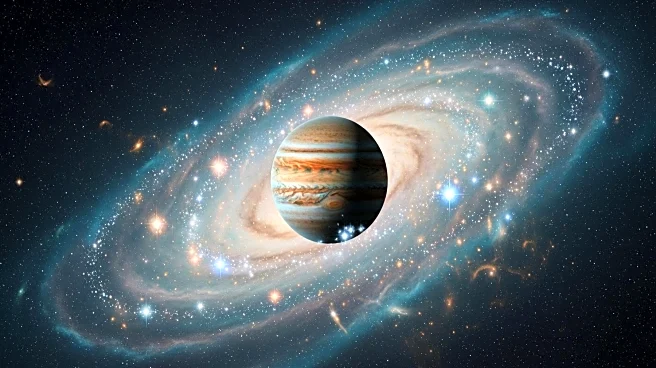What is the story about?
What's Happening?
Astrophysicist Susanne Pfalzner has introduced a novel theory suggesting that interstellar objects could play a crucial role in the formation of gas giants around young stars. This theory was presented at a scientific conference in Germany, where Pfalzner posited that these cosmic visitors might act as 'seeds' for planet formation. Traditional models of planet formation, which rely on the accretion of smaller particles, often fail to explain the rapid emergence of massive planets like gas giants. Pfalzner's hypothesis suggests that interstellar objects, when captured by the accretion disks of young stars, could provide the necessary mass to initiate the planet formation process. This idea challenges existing theories and could revolutionize our understanding of planetary genesis.
Why It's Important?
The implications of Pfalzner's theory are significant for the field of planetary science. If interstellar objects are indeed pivotal in the formation of gas giants, this could explain the prevalence of such planets around larger, Sun-like stars. These stars retain their planet-forming disks for a relatively short period, making the rapid formation of gas giants without external assistance unlikely. Interstellar objects could provide the additional mass needed to accelerate this process. Furthermore, the theory offers insights into the rarity of gas giants in M dwarf star systems, suggesting that these stars are less efficient at capturing interstellar objects. This research could reshape our understanding of the diversity of exoplanetary systems and the factors influencing their architecture.
What's Next?
Future research will focus on investigating the quantity and distribution of interstellar objects within accretion disks. Understanding their prevalence could provide critical insights into the processes that shape planetary systems. Additionally, ongoing observation and analysis of interstellar objects like 3I/ATLAS will refine our understanding of their composition and origins. As research continues, the scientific community anticipates further evidence that could confirm the influence of these cosmic voyagers on planet formation. The exploration of these celestial mysteries is far from complete, with much still to unravel.
Beyond the Headlines
Pfalzner's hypothesis could have profound implications for our understanding of the universe. If validated, it could redefine established theories of planet formation and highlight the importance of interstellar objects in shaping planetary systems. This research also underscores the efficiency of higher-mass stars in capturing interstellar objects, facilitating faster planet formation. The study of these cosmic visitors presents an exciting opportunity to rethink established theories and explore new avenues in planetary science.
AI Generated Content
Do you find this article useful?















